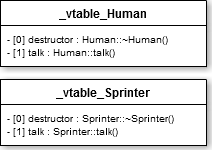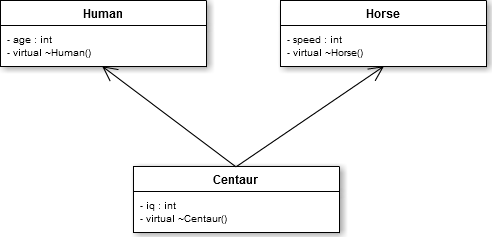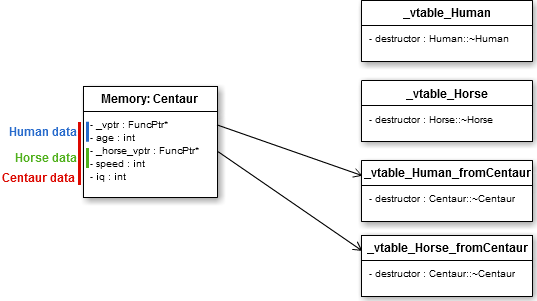Here, I will explain what happens when you use the virtual keyword in C++.
This post will cover the following topics:
virtualkeywordvtable(virtual function tableorvirtual method table) andvptrthispointer and virtual functions
I will use many code examples, so don't worry if you don't understand something, look at the code example and it would be ok :)
# Virtual keyword
When you use a pointer to a base class that was instantiated from a derived class, you can use the virtual keyword to call functions from the real instance.
#include <iostream>
/*
Human is the base class:
*/
class Human
{
public:
virtual ~Human()
{
}
void sayHello() const
{
std::cout << "Hello, I'm a Human!" << std::endl;
}
virtual void talk() const
{
std::cout << "Hey, how are you?" << std::endl;
}
};
/*
Sprinter is the derived class:
*/
class Sprinter : public Human
{
public:
/*
Declaring a destructor is not mandatory here as we already declared a
virtual destructor in the base class "Human" (the compiler will
automatically create a default virtual destructor).
*/
virtual ~Sprinter()
{
}
void sayHello() const
{
std::cout << "Hi, I'm a Sprinter!" << std::endl;
}
virtual void talk() const
{
std::cout << "Do you like to run?" << std::endl;
}
};
int main()
{
/*
implicit static_cast from Sprinter* to Human*:
*/
Human* fakeHuman = new Sprinter();
Human* human = new Human();
/*
"sayHello" is a non-virtual function:
internals: resolving to Human::sayHello() at compile time
output: Hello, I'm a Human!
*/
fakeHuman->sayHello();
/*
"talk" is a virtual function:
internals: resolving to Sprinter::talk() at runtime (dynamic call)
output: Do you like to run?
*/
fakeHuman->talk();
/*
"sayHello" is a non-virtual function:
internals: resolving to Human::sayHello() at compile time
output: Hello, I'm a Human!
*/
human->sayHello();
/*
"talk" is a virtual function:
internals: resolving to Human::talk() at runtime (dynamic call)
output: Hey, how are you?
*/
human->talk();
/*
Thanks to the virtual destructor declared in "Human", this object will be
destroyed properly by calling Sprinter::~Sprinter() destructor, then
the Human::~Human() destructor.
*/
delete fakeHuman;
/*
Human::~Human() is called here:
*/
delete human;
return 0;
}
Ok, we understand how to use the virtual keyword, but how the compiler manages to call the correct function?!
# vtable and vptr
A virtual function table is like a static array that contains pointers to the (virtual) functions of a class.
Each class having at least one virtual function will get its own vtable.
When one of these classes is instantiated, it gets an extra variable member (called vptr) that will contains a pointer to its vtable.
Here's what the vtables might look like:
You have to know that when you compile a C++ code, the class functions are transformed into regular functions having an extra parameter: a pointer to the instance of the class, named "this" (yes, that's where the "this" pointer comes from).
So, a class function void Human::talk(); could be transformed to a C function like void _human_talk(Human* this); (you can Google C++ name mangling if you are interested to know how compilers name symbols after C++ function names).
To simplify, let's use a FuncPtr type as a basic pointer to function: typedef void (*FuncPtr)(void* this);
The Human vtable might be:
static const FuncPtr _vtable_Human[2] =
{
&_human_destructor,
&_human_talk
};
The compiler just has to add an extra variable member to these classes: private: FuncPtr const (*_vptr)[2];
Then initialize it in the constructor of these classes.
In the constructor of Human: this->_vptr = &_vtable_Human;
In the constructor of Sprinter: this->_vptr = &_vtable_Sprinter;
When you call a virtual function, the compiler just has to look at the vtable to call the correct function.
When you write:
Human* human = new Sprinter();
human->talk();
A compiler might generate this code:
/*
The constructor of Sprinter will initialize the _vptr attribute:
*/
Human* human = new Sprinter();
/*
[0]: destructor, [1]: talk
*/
FuncPtr talkPtr = human->_vptr[1];
/*
Call to the correct function! Here, "human" is the "this" pointer.
It's sometimes a little bit more complicated to get a correct
"this" pointer (more on that below):
*/
(*talkPtr)(human);
For your information, you can call a specific implementation of a class function by explicitly naming it:
Human* human = new Sprinter();
/*
Will NOT use the vtable, and will directly call "talk"
implementation of the Human class:
*/
human->Human::talk();
# this pointer and virtual functions
Sometimes, the compiler has to do a little bit of arithmetic to pass the correct this pointer to a virtual function.
Imagine a class Centaur that inherits from both Human and Horse:
Here is a possible memory representation of the Centaur class (note: in this example, the compiler optimizes the memory by using the same vptr attribute for both the Human and Centaur classes):
So, what happens if we delete an instance of Centaur through a pointer to Human?
As the data for a Human and a Centaur starts at the same position in memory, no special operations are needed. The this pointer is the same for both classes.
But what happens when we use an instance of Centaur through a pointer to Horse?
Well... the static cast from a Centaur pointer to a Horse pointer will move the data pointer from some bytes (from the Centaur data to the Horse data).
Centaur* centaur = new Centaur();
/*
Internally:
human = ((void*)centaur) + 0; // <= same pointer!
*/
Human* human = static_cast<Human*>(centaur);
/*
Internally:
horse = ((void*)centaur) + sizeof(Human); // <= different pointer!
*/
Horse* horse = static_cast<Horse*>(centaur);
So, when you delete the "horse" pointer that is an instance of Centaur, how the compiler passes the correct this pointer?
A way to do that (the g++ way!) is to use a "wrapper" that will modify the this pointer then call the correct function.
void _destructor_horse_fromCentaur(Horse* this)
{
/*
Internally:
centaur = ((void*)this) - sizeof(Human);
*/
Centaur* centaur = static_cast<Centaur*>(this);
/*
Call to Centaur::~Centaur() then operator delete(centaur)
to free the memory.
*/
_destructor_centaur(centaur);
}
The vtable of Centaur will use the _destructor_centaur function as destructor.
While the vtable of Horse instantiated from a Centaur will use the _destructor_horse_fromCentaur function as destructor.
I hope this explanation helped you to understand how the "magic" of C++ really works!
Please tell me if I made some mistakes or if something is unclear. Thank you!












